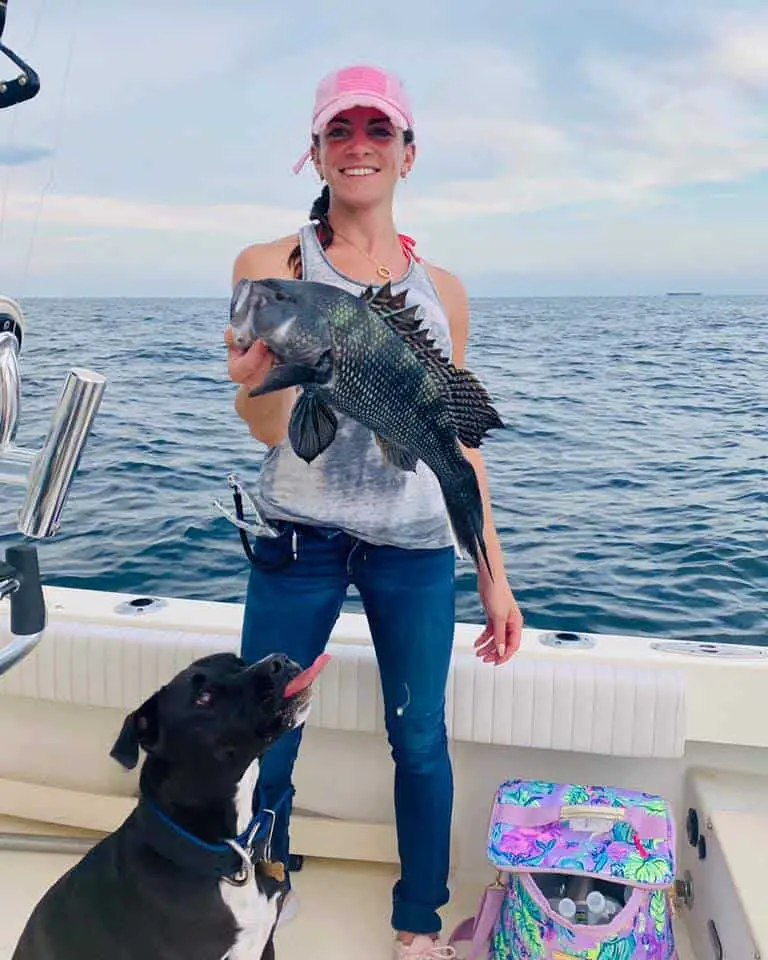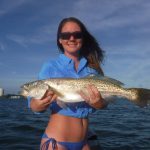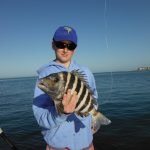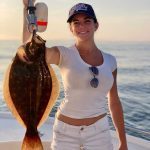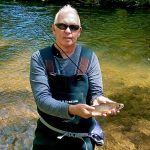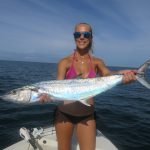Black Sea Bass Fishing – Tips, Tackle, and Techniques
This article will thoroughly cover black sea bass fishing. Black sea bass are a popular and fairly abundant bottom species caught by anglers. They are a beautiful fish that puts up a nice little scrap on light tackle. However, they are mostly prized for their incredible snow-white and tasty fillets! Black sea bass are a staple of charter boat captains from Maine to Texas.
Black sea bass, Centropristis striata, is in the family Serranidae, which includes grouper. They are a bottom dwelling species. Black sea bass relate to structure and are usually found quite close to ledges, wrecks, reefs, and other man made structure. Most sea bass are caught by anglers fishing with natural bait. However, artificial lures such as jigs and spoons are productive as well.
Black sea bass fishing
Black sea bass grow relatively slowly. They live around 8 to 10 years and can grow as large as 10 pounds. However, the vast majority of fish caught are between 1 pound and 4 pounds. They range from New England south along the Atlantic coast and in the Gulf of Mexico. Black sea bass prefer cool water and make a seasonal migration. Anglers will find them offshore and in the southern states in the cooler months and in the coastal waters of the North Atlantic in the summer time.
Black sea bass are opportunistic feeders. They have quite the varied diet and will eat just about any type of bait fish, crustacean, and other marine animals such as worms. They are quite aggressive as well. These trades combine to make them fairly easy for anglers to catch, once a school is located. Bottom fishing with live or cut bait or bouncing spoons are jigs off the bottom will be productive.
Black sea bass fishing tackle
“Fishing Lido Key is a participant in the Amazon Associates Program, an affiliate advertising program designed to provide a means for sites to earn advertising fees by advertising and linking to Amazon. As an Amazon Associate I earn from qualifying purchases. ”
Click this link to shop Amazon for Penn Conventional outfits
Anglers fishing for black sea bass do not need any special tackle or equipment. In fact, most saltwater anglers already own outfits that are more than adequate for the job. Black sea bass relate to structure and are caught by anglers using basic bottom fishing tackle and techniques. The tackle required will basically depend on the size of the fish that are available as well as the water depth and current that the angler is fishing in.
A medium spinning outfit is fine for chasing sea bass inshore and in relatively shallow water. In fact, it is preferred in many applications were anglers want to anchor a distance away from a piece of structure and cast to it. Spinning tackle is the best choice in this situation. A 7 foot medium action rod with a 3000 series reel spooled up with 20 pound braided line is an excellent all round combination.
Light or medium light conventional or bait casting tackle is an excellent choice when fishing and slightly deeper water, around heavy structure, and strong currents, and for larger black sea bass. Conventional outfits provide more power than a spinning reel. This makes them a better choice when heavier sinkers are required as well as when fishing around heavy structure or for larger fish.
Black sea bass fishing rigs
Anglers will do well to keep it simple when it comes to rigs for black sea bass fishing. A couple of rigs will get the job done in the vast majority of applications. In fact, the basic chicken rig, also known as a spreader rig or high low rig, is really the only rig that most anglers pursuing sea bass will need. Again, these are not complicated fish that are aggressive and school near the bottom.
While the chicken rig will suffice in many sea bass fishing situations, the second rig an angler can add to the arsenal is the sliding sinker rig or Carolina rig. Anglers can go to this when black sea bass are especially finicky. This rig allows the fish to pick up the bait and move off with it without feeling the weight of the sinker.
Anglers have a couple different choices when it comes to hooks for black sea bass fishing. Many anglers have switched over to circle hooks as they age greatly and releasing a fish with less damage. Most fish hooked with a circle hook will be done so in the mouth as opposed to the hook being swallowed. In fact, circle hooks are now required for Florida and much of the Gulf of Mexico.
Standard “J” hooks are still quite popular with many anglers. This is especially true for those who like to set the hook, which does not work well when using circle hooks. It is important for anglers to match the size of the hook to the bait being used in the size of the fish being pursued. In most instances, a #1/0 standard hook or #3/0 circle hook is a good all-around hook and less the fish are running especially large.
Bottom fishing tips
While bottom fishing is pretty straightforward, there are a few tips that will help anglers be more successful when bottom fishing for sea bass as well as other species.
Anglers should use the minimum amount of weight required to reach and hold the bottom. It is fine if the bait bounces and moves a little bit. This can actually increase the effectiveness of the presentation. The weight needed to accomplish this will change constantly with tidal flow as well as depth. This is one reason the chicken rig is so popular, it allows for easy sinker changes.
Many anglers set the hook when bottom fishing. While this works with “J” hooks, it will not with circle hooks. In fact, Capt Jim advises his clients, no matter which style hook is used, to simply come tight and reel while slowly lifting the rod tip. Also, it is best to wait out the little nibbles. Eventually, the fish will take it and the angler will feel a steady pull. This is the time to reel quickly and come tight on the fish.
Top black sea bass fishing baits
The list of baits that will fool black sea bass is quite long. In fact, the list of baits they will not eat is much shorter than the list of baits that they will eat. Squid is a universal cut bait that is available at every saltwater bait and tackle shop. Sea bass will readily devour a nice strip or chunk of squid.
Other available cut baits or frozen baits will depend on the geographical area. In the Gulf of Mexico as well as the southern Atlantic coast, shrimp work very well for sea bass and just about every other saltwater species. They can be used both live and a fresh dead or frozen. They do not stay on the hook as well as some cut baits, but are extremely effective.
Various clams and the crabs also make excellent black sea bass fishing baits, depending on the region. These are available both at bait shops as well as being caught or a tainted by the angler. Anglers can also catch a fresh fish and then cut it up for bait as well. The baits can be cut into long strips or chunks. Fresh cut fish works very well when currents are strong or when crabs become a nuisance. Anglers must check local regulations to make sure they are in compliance.
Fishing with artificial lures for black sea bass
The aggressive nature of black sea bass makes them a natural for anglers who prefer to use artificial lures. Since these fish are almost always found on or near the bottom, lures that are presented in this part of the strike zone are most effective. The two most popular lures for sea bass fishing are jigs and jigging spoons. Both of these lures are made to fish right on the bottom where sea bass feed.
Jigs can be used in a vertical presentation when fishing for sea bass over structure in deeper water. Often times, a strip of squid or cut bait is added to sweeten the lure. A white buck tail jig is tough to be in this application. Black sea bass can often be found on flats and water between 5 feet deep and 10 feet deep. Anglers drifting with the wind and current will do well casting jigs out in front of the boat. A 1/4 ounce to 1/2 ounce lead head jig with a 3 inch soft plastic grub body is an excellent combination.
Heavy jigging spoons are excellent artificial lures to use for black sea bass when they are schooled up over structure in fairly deep water. These spoons are compact yet dense and heavy allowing them to sink quickly through the water column. Once at the bottom, the angler jerks the rod tip sharply and allows the spoon to fall on a semi-tight line. This is a highly productive technique for sea bass and many other wreck and reef species.
Top black sea bass fishing spots
Black sea bass will almost always be found relating to some type of structure. The structure will vary depending on the geographical location that an angler is fishing. Many black sea bass are an unintentional, but most welcome, catch of anglers fishing for other species such as grouper, snapper, flounder, and tautog. Basically, the same types of bottom structure that produce for these and other species will hold sea bass as well.
Fishing for black sea bass offshore
In the offshore waters of the Gulf of Mexico and Atlantic Ocean, natural ledges, artificial reefs, and wrecks are the top sea bass fishing spots. Many of the spots are published in the numbers are available at bait and tackle shops as well as online directories. However, the best spots are often smaller “private” spots that get much less fishing pressure.
Anglers fishing these offshore spots can either anchor or drift. Generally speaking, anchoring works best on a smaller piece of structure while drifting is more productive in a larger area such as a patch of hard bottom or coral. Either way, anglers can bottom fish with bait on a two hook chicken rig or bounce a lure off of the structure.
Modern GPS trolling motors have revolutionized the bottom fishing and allow anglers with larger bait boats pin point boat positioning. This is a huge advantage that allows anglers to thoroughly cover a piece of structure while keeping the bait in the strike zone the entire time.
Fishing for black sea bass inshore
Anglers fishing for black sea bass inshore will often times be fishing man-made structure. Bridges are sea bass magnets! The same bridges that fluke and flounder anglers love will produce sea bass as well. Docks and piers are also structures that will hold fish. Finally, rocks, rip-rap, jetties, and areas of rocky bottom are prime spots to try.
The best approach in the shallower inshore waters is usually to anchor a cast away up current of the structure to be fished. Feeding fish almost always face into the current so it is best for anglers to present baits back to the fish in this manner. This is one situation where the sliding sinker rig works well.
Black sea bass will also be found on the open flats, particularly in areas of submerged vegetation and oyster or shall bottom. Sea bass feed heavily on crustaceans of all types, in these areas will certainly hold them. On larger areas, the best approach is to drift the area while casting a jig or bouncing a bait along the bottom. If a very productive area is located, anglers can re-drift that area or anchor up and thoroughly fish it.
In conclusion, this article on black sea bass fishing will help anglers catch more of these tasty and hard fighting saltwater pan fish!
